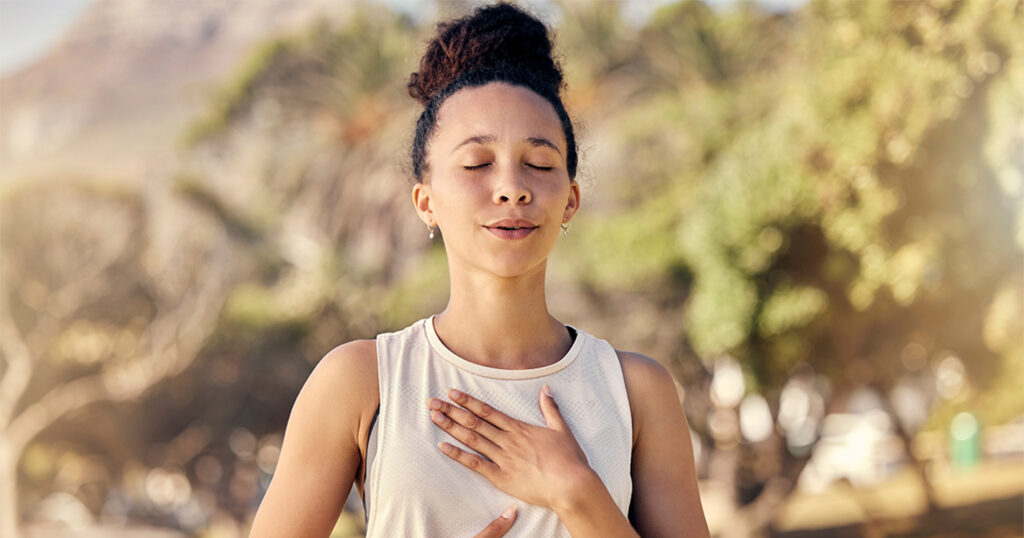What is Yogic Breathing?
Yogic breathing, or pranayama, is the art of controlling one’s breath, a vital life force known as “prana” in the yogic tradition. It goes beyond simple inhalation and exhalation. Pranayama is a mindful technique that harmonises body, mind, and spirit, especially when paired with yoga poses.
Through conscious yogic breath control, pranayama helps calm the mind, reduce stress, and improve physical well-being. Research supports its benefits, showing how these breathing techniques can enhance lung function, balance emotions, and promote mental clarity.
By learning to regulate your breath, you can transform your physical and emotional state, bringing a sense of focus and tranquillity into your daily life.
Yogic Breathing Techniques
Let’s explore some critical yogic breathing techniques and their powerful effects.
- Nadi Shodhan Pranayama (Alternate Nostril Breathing)
This potent yogic breathing technique is a natural stress reliever to calm the mind and restore inner balance. To practice, use your right thumb to gently close your right nostril and inhale deeply through the left. Then, close your left nostril with the ring finger of your right hand and exhale through the right. Inhale again from the right nostril, switch, and continue alternating. With each long, intentional breath, you’ll feel tension and anxiety melt away, leaving you more centred and relaxed. - Lion’s Breath (Simhasana)
Unleash your inner lion with this powerful, invigorating breathwork. Start by kneeling on the floor or sitting comfortably in a chair. Inhale deeply, open your mouth, stick out your tongue, and forcefully exhale with a roaring “ha” sound. As you release, focus on your third eye chakra between your eyebrows. This dynamic exercise not only relieves stress but energises your entire being. Repeat several times to feel its uplifting effects.

- Ocean Breath (Ujjayi)
Ujjayi, or “Ocean Breath,” is a profoundly grounding yogic breathing technique that mimics the soothing sound of ocean waves. To practice, inhale deeply through your nose, then gently constrict the back of your throat as you exhale through your mouth, creating a soft, wave-like sound. This breathwork calms the mind and generates internal heat, helping you flow through your yoga practice with more energy and focus. Though it may take a little time to master, the peaceful rhythm of Ujjayi breath brings a profound sense of calm and stability. - Humming Breath (Bhramari Pranayama)
In Bhramari, or “Humming Breath,” you’ll create a gentle vibration that soothes the mind and sharpens focus. Start by inhaling deeply through your nose, then hold your breath momentarily. As you exhale, hum softly, allowing the sound to resonate throughout your body. This simple yet powerful technique reduces anxiety, improves concentration, and leaves you feeling centred and peaceful. It’s like a personal sound bath for your mind.
- Hissing Breath (Siitkari Kumbhaka)
Siitkari Kumbhaka is a refreshing yogic breathing technique that cools the body and calms the mind. Begin by inhaling deeply through your nose, then hold your breath for about eight seconds. As you exhale, release the air slowly through your mouth, producing a gentle hissing sound, like a soft breeze. This practice helps cleanse the senses, reduces head, neck, and upper digestive tract heat, and brings a refreshing sense of clarity and calm. - Active Yogic Breathing
Active yogic breathing is a dynamic practice that combines movement with deep, mindful breaths. As you walk steadily, inhale slowly and deeply through your nose, then exhale slowly. This completes one entire, intentional yogic breath cycle. As you continue walking, gradually extend the length of each breath, enhancing the calming effect. This technique seamlessly merges physical activity with the power of yogic breathing, promoting both mental calmness and physical vitality.
Finding an Instructor for Yogic Breathing
If you’re ready to explore the transformative power of yogic breathing, it’s best to do so under the guidance of a skilled instructor. An experienced teacher ensures you’re practising correctly, helping you unlock the full benefits of these powerful techniques. Our SoulSensei, Prameet Kotak, specialises in breathwork and optimising sleep patterns to elevate performance and well-being. Whether you’re just starting or looking to deepen your practice, we support and guide you to a healthier, more balanced life. Reach out to us and start your transformation today.
The secret of life is right under your nose!
Dan Brule
Sources
- “9 Yogic Breathing Practices for Mind-Body Balance and Healing.” Himalayan Yoga Institute, Himalayan Yoga Institute.
- Hellicar, Lauren. “What Is Yogic Breathing? Benefits and How to Try It.” Medical News Today, MediLexicon International, 16 Sept. 2022.
- Stephanie. “50 Inspiring Breathing Quotes.” Be Buddy, Balancing Elephants, 9 Mar. 2022.